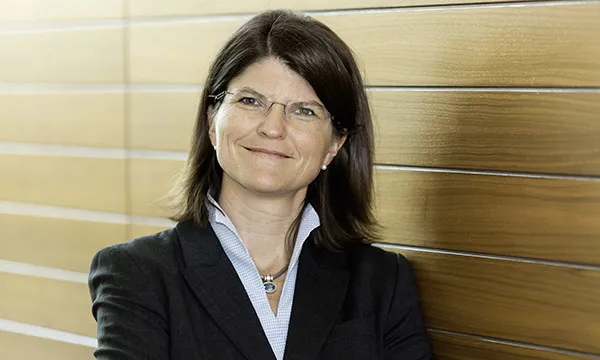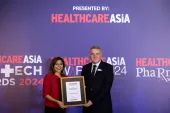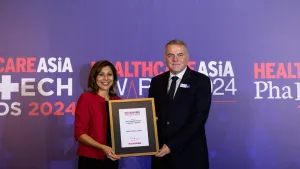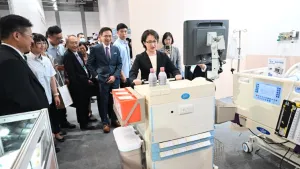
Paving the way for the digital transformation of healthcare
Siemens Healthineers developed a cloud-based network called “teamplay” to meet the demands of a digitalised industry.
Healthcare Asia caught up with Elisabeth Staudinger, President of APC, Siemens Healthineers, to discuss the industrialisation of healthcare, as well as how customers can get on top of the digital transformation.
What healthcare trends are you currently addressing arm-in-arm with healthcare providers?
Globally, and even more in Asia Pacific, we see the demand for healthcare, as well as the cost of healthcare rising. I believe that one way to address this challenge is
through innovative products and solutions. Another trend is that of healthcare providers merging to gain competitive advantages through more specialised offerings. Within Asia Pacific, Australia is a good example for this consolidation: We are looking at only a handful of providers, who run very large scale operations.
We notice this trend in most developed countries around the world: The average deal size for hospital acquisitions in the U.S. has grown five times the volume size in
just six years - from 42 Million USD to 224 Million USD. We are also witnessing an industrialisation of healthcare: Our industry is increasingly taking cues from other industries such as manufacturing. Just think of their success factors such as short waiting times, reduced space requirements or low error rates.
That sounds familiar to our industry, right? To meet this demand, we at Siemens Healthineers have developed a cloud-based network called “teamplay”. How does it
work? It allows users to analyse, benchmark, optimise and standardise the utilisation of their imaging equipment across multiple sites. Idle times of machines but also waiting times for patients can be reduced. Especially for large consolidated healthcare providers, standardisation and delivering the same level of care within all parts of an institution is very important.
What are Siemens Healthineers’ plans in expanding and strengthening its foothold in the Asia Pacific region?
Asia Pacific is a very diverse region in terms of economics, language and culture – and hence, market requirements. We as Siemens Healthineers are present in every major country in the region. What’s more, we can count on an extensive network of carefully selected partners, which we are continuously expanding, especially to increase coverage in rural areas.
On top of that, we clearly have the right portfolio and a great global reach: Every single hour, more than 200,000 people worldwide are being diagnosed or treated with our devices. And in the past year alone, we’ve launched a variety of products under our new name. Let me give you two examples: For one, in the field of Laboratory Diagnostics, we’ve developed Atellica Solution, a new lab automation system. It comes with a special sample transport technology which makes it ten times faster than conventional technologies. Furthermore, it delivers the industry’s highest productivity per square meter – more than 400 tests per hour.
Secondly, in the field of value-based healthcare, we’ve introduced SOMATOM Go., an entirely new platform for computed tomography (CT) at a very affordable price.
It offers automated, standardised workflows that help users achieve profound clinical results. The multi-year service packages and corresponding high financial reliability
help our customers to run their business predictably and successfully.
What are Siemens Healthineers’ top three priorities for Asia this year?
We are keen on helping healthcare providers to get on top of the ongoing digital transformation. The aforementioned ‘teamplay’ is one part of the puzzle. Based
on teamplay’s technology, we’re currently building a platform, a Digital Ecosystem, which is linking healthcare providers and solution providers, as well as their data
and knowledge. We have already teamed up with partners whose offerings will be integrated into our Digital Ecosystem.
And we are keen to grow this platform further, paving the way for the digital transformation of healthcare. We have set ourselves ambitious goals: Worldwide, we
would like to connect 1,000 customers via teamplay in the course of this year.
Furthermore, we are currently expanding our eHealth offerings, e.g. for teleconsultation, or patient and physician portals. Recently, we have entered into the field of population health management by forging a global alliance with IBM Watson Health. By that we aim to help hospitals, health systems, integrated delivery networks, and other providers deliver value-based care especially to patients with complex, chronic and costly conditions such as heart disease and cancer. We’re continuously expanding our value-added services.
We have been entering into so-called long term enterprise services contracts with customers. Those agreements have life spans of up to 40 years. Only recently, we
agreed with a newly constructed hospital in Perth, Australia, on procuring, installing, and managing the entire base of medical devices. And we have a team on-site in
charge of running biomedical services within the hospital. These kinds of projects make me very proud as they show that customers are having great trust in us.
Disclaimer: “The products/features (here mentioned) are not commercially available in all countries. Due to regulatory reasons their future availability cannot be guaranteed. Please contact your local Siemens organization for further details.”


















 Advertise
Advertise


